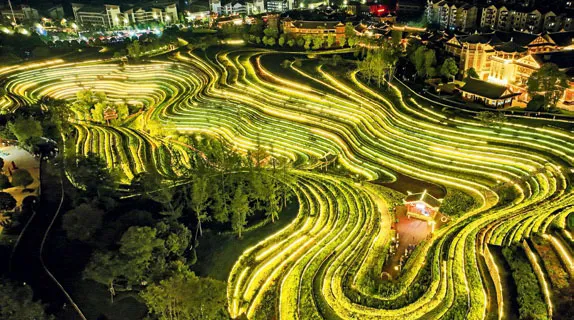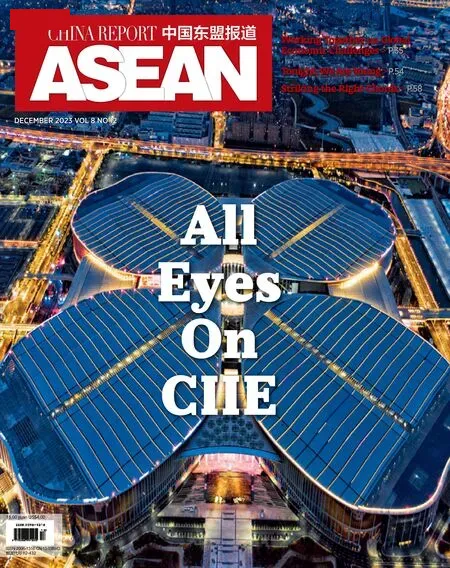The Future Direction OfUrbanization
By Tao Xing

Aerial photo taken on July 12,2023 shows night view of terraced fields in Shexiang Ancient Town,Bijie City,Guizhou Province.The ancient town is a resettlement area for poverty alleviation,and the construction of 120,000 square meters of terraced fields there embodies local efforts to integrate natural scenery into urban construction.(QU HONGLUN)
China’s urbanization rate reached nearly 64 percent in 2020,up from 49.7 percent in 2010,according to the results of the seventh national census released by the National Bureau of Statistics.The census was conducted in 2020.The country had a total population of 1.412 billion that year,with 901.99 million living in urban areas and 509.79 million in rural areas.The 14th Five-Year Plan (2021-2025) has set an urbanization target of 65 percent by 2025.Five-year plans are China’s policy blueprints for medium-term social and economic development.
The report delivered to the 20th National Congress of the Communist Party of China (CPC) in October 2022 further underscores the basic achievement of new urbanization as one of China’s overall development objectives to be achieved by the year 2035.The report outlines goals and tasks for the development of the country in the next five years and beyond.According to a two-step strategic plan laid out in the report,China will largely realize socialist modernization from 2020 through 2035 and then build itself into a great modern socialist country that is prosperous,strong,democratic,culturally advanced,harmonious,and beautiful from 2035 through the middle of this century.
At a forum,China’s New Urbanization: Theory,Policy and Practice,held at Tsinghua University on October 31,participants discussed how to best navigate the path of highquality and sustainable urbanization,and also how to make the most of the role of urbanization in the process of national modernization.In terms of the new urbanization strategy,they called for a more people-orientated approach,more integrated rural and urban planning,and acceleration of urban renewal.
The forum was jointly hosted by the university’s Institute for China Sustainable Urbanization and Institute for National Governance and Global Governance.
People-Centered
Taking a people-centered approach in advancing new urbanization has been emphasized in different official documents,including the new urbanization implementation plan during the 14th Five-Year Plan period,approved by the State Council,the country’s highest state administrative organ,in June 2022.
Zhou Nan,former deputy directorgeneral of the Department of Development Planning of the National Development and Reform Commission,focused on issues related to migrant workers’ access to public services and social security in urban areas in her speech to the forum.
China’s household registration system,or hukou,classifies each person as a rural or an urban resident according to their birthplaces or their parents’ hometowns.The vast majority of people leaving rural areas to work in cities maintain their rural registrations and are known as urban migrants.
“We need to focus on two groups,”Zhou said at the forum.“We must ensure migrant workers of retirement age who are about to exit or have already withdrawn from the labor market can live stable lives after returning to their rural hometowns.For the new-generation migrant workers,especially those born in the 1990s and 2000s,it is necessary to strengthen training organized by enterprises,and to provide affordable housing.”
According to a March report by Workers’ Daily,Shanghai,Shenzhen in Guangdong Province,and some other cities implemented policies to discontinue the employment of migrant workers over 60 at construction sites because of safety concerns.Although well-intentioned,the measures were met with mixed feelings from those facing imminent job losses,especially for those with children who are still not financially independent.

Zhou called for greenlighting migrant workers in the advanced age group to engage in jobs suitable for their age and health.She also suggested further deepening the reforms allowing migrant workers to participate in social insurance systems in their place of permanent residence or employment rather than their rural hometowns,which means better retirement benefits than under the current urbanrural dual-track pension fund system.
Building a modern socialist country requires continuous promotion of urbanization,Zhou said.If the correct goals for urbanization are set,the direction of progress will be right,and a new path can be found,which will produce huge and wide-ranging benefits.
Integration
Liu Shouying,dean of the School of Economics at Renmin University of China,called for the continued narrowing of the urban-rural divide and the promotion of integrated development.
Urbanization is not a process of simply transforming villages into cities,but a process that involves different stages,according to Liu.One stage is that of suburbanization,an inevitable trend.
Moreover,suburbs,as integrated areas that connect cities and villages,play an important role in narrowing the urban-rural divide.For example,people and industries flow into the suburban areas from the central city.Suburban development then further extends into the rural areas,in turn boosting rural development and revitalization.This process can narrow the urban-rural income gap.
China must promote the role of county towns,which also connect cities and villages,as hubs for advancing new urbanization,Liu said.He suggested the promotion of the “one county,one industry” strategy,which focuses on the development of the industries in which particular counties have advantages,rather than developing a broader range of industries that may be less profitable.
Last year,the central authorities released guidelines on promoting urbanization with a focus on county towns.The guidelines,jointly issued by the General Office of the CPC Central Committee and the State Council General Office,list a series of measures including developing competitive industries,creating more jobs in county towns,and strengthening ecological conservation,adding that by 2025,major progress will be seen in the drive.
Upgraded
Jingdezhen,a city in the eastern province of Jiangxi famous for its quality porcelain products,is now renowned for its protection and utilization of ceramic industrial heritage.
The city’s Taoxichuan (meaning Streams of Ceramics) development project transformed an old industrial area into a modern art and recreation precinct,restoring and protecting 22 old porcelain factory buildings,kilns and other facilities.The artists’ studios,galleries,showrooms,restaurants,cafes and parks now housed within these restored facilities have made Taoxichuan one of the city’s most popular tourist attractions.
Zhang Jie,a professor of urban planning and design at Tsinghua University who participated in designing the project,said the urban renewal work in Jingdezhen is bringing the city economic,environmental and social benefits,and has expanded employment opportunities.
The cultural protection and inheritance-led green renewal has promoted the overall revitalization of the city,according to Zhang.
Li Zheng,president of the Institute of Climate Change and Sustainable Development at Tsinghua University,said low-carbon development in cities and towns is essential for achieving China’s dual carbon goals of peaking its carbon dioxide emissions before 2030 and achieving carbon neutrality before 2060.
New urbanization requires the coordinated development of society,economy and nature,Li said.He suggested building urban spaces that integrate business,living and ecology,and that make use of resource conservation,environmental protection and climate-friendly sustainable development practices.

